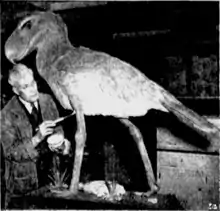Mesembriornis
Mesembriornis is a genus of intermediate-sized phorusrhacids that grew up to 1.5 metres (4.9 ft) in height. They represent a well-distinct lineage of terror birds, differing from the massive large groups and the smaller Psilopterinae. In general proportions, they most resembled the Patagornithinae which flourished somewhat earlier, mainly to the south of the range of Mesembriornis.[1] Fossils of the terror bird have been found in Montehermosan deposits of the Monte Hermoso Formation in Argentina.[2]
| Mesembriornis | |
|---|---|
 | |
| Leg bones | |
| Scientific classification | |
| Kingdom: | Animalia |
| Phylum: | Chordata |
| Class: | Aves |
| Order: | Cariamiformes |
| Family: | †Phorusrhacidae |
| Subfamily: | †Mesembriornithinae |
| Genus: | †Mesembriornis Moreno, 1889 |
| Type species | |
| Mesembriornis milneedwardsi Moreno, 1889 | |
| Species | |
| |
| Synonyms | |
| |
Taxonomy
Two species are nowadays accepted, Mesembriornis incertus and Mesembriornis milneedwardsi. However, this was recently disputed by an author who claimed Mesembriornis to be a nomen nudum, renamed the genus Hermosiornis and proposed a new taxonomic systematics for the family.[3] Mesembriornis lived on the pampa of eastern Argentina, from the Late Miocene to the Late Pliocene, roughly 5.3 to 4 million years ago.[1] Together with the North American giant Titanis walleri, it was among the last terror birds alive.[1]
Debate on Mesembriornis habits

A study called "Terror Birds on the Run" measured how fast ancient terror birds could run.[4] It was found that a terror bird's average top speed was 70 kilometres per hour (43 mph), and this is not heavily disputed. However, the speed of Mesembriornis specifically is now heavily debated. This is probably because the method of calculation was not as accurate as other mathematical methods. These methods are impossible because, like other terror birds, this beast's bones are fragmentary. There are two main theories about how Mesembriornis hunted:
- "Crushing Kicks"
A group of scientists have suggested that terror birds had bone-shattering kicks. They may have used this kick to take down prey or defend kills. If it also attained the speed first thought as well as this kick, it could not have been forced off kills as easily as cheetahs in Africa.
- "Cheetah of the Tertiary"
This school of thought suggests Mesmbriornis may have lived akin to a modern-day cheetah, eating the smaller notoungulate mammals of the time (Miocene) using its speed to outrun the beasts. Its top speed is a matter of debate, but estimates go up to 90 kilometres per hour (56 mph). Some other scientists like to scale down the predator's speed to 85, 80, 75 or even the average phorusrhacid speed of 70 km/h.
References
- Alvarenga & Höfling (2003)
- Mesembriornis at Fossilworks.org
- Agnolin (2013)
- Blanco & Jones (2005)
Bibliography
- Alvarenga, Herculano M.F. & Höfling, Elizabeth (2003): Systematic revision of the Phorusrhacidae (Aves: Ralliformes). Papéis Avulsos de Zoologia 43(4): 55-91 PDF fulltext
- Agnolin, L. (2013): La position sistemática de Hermosiornis (Aves, Phororhacoidea)y sus implicancias filogenéticas.Revista del Museo Argentino de Ciencias Naturales 15(1): 39-60
- Blanco, Ernesto R. & Jones, Washington W. (2005): Terror birds on the run: a mechanical model to estimate its maximum running speed. Proceedings of the Royal Society B 272: 1769-1773